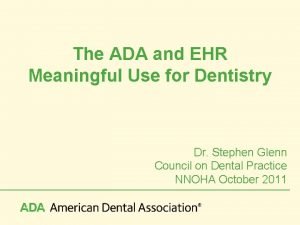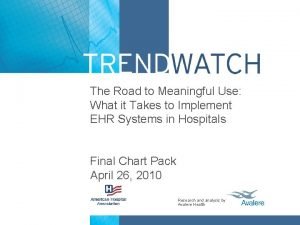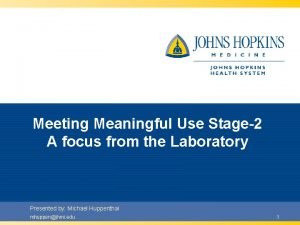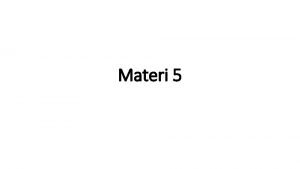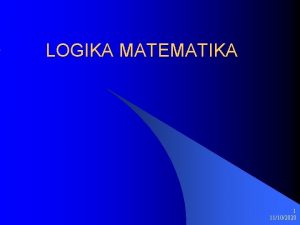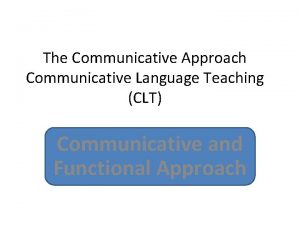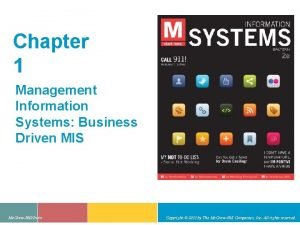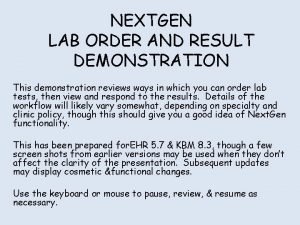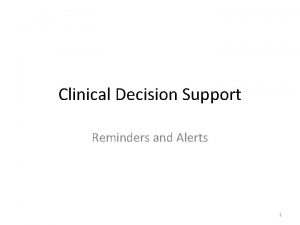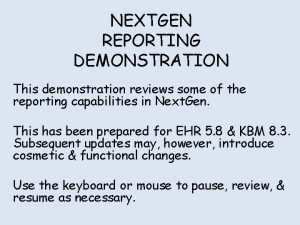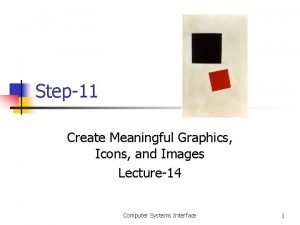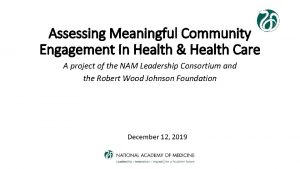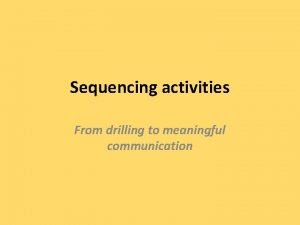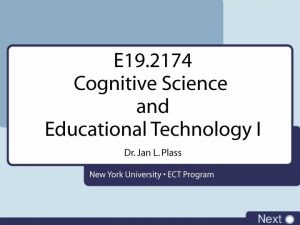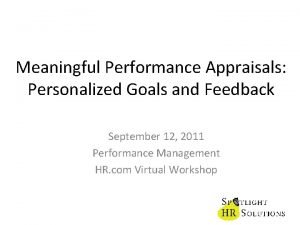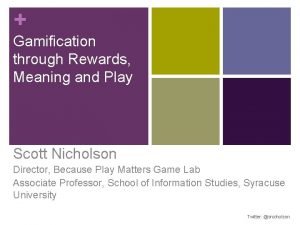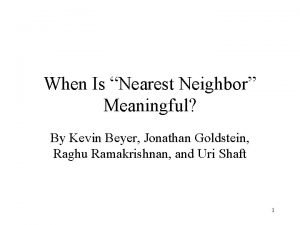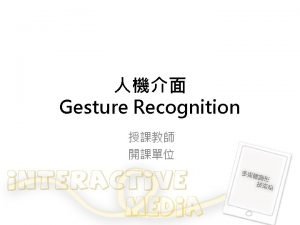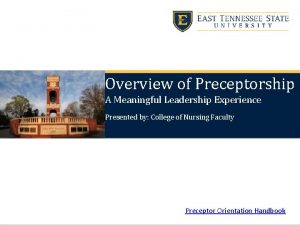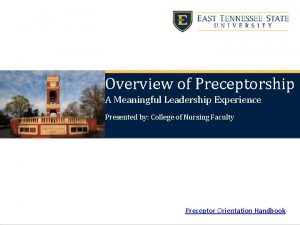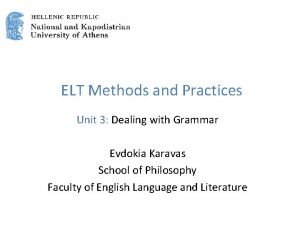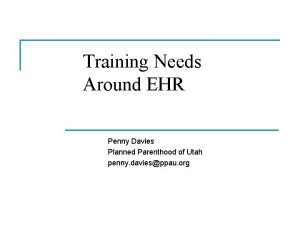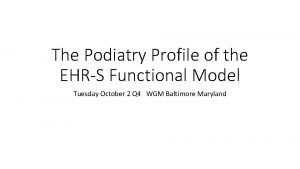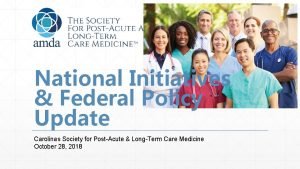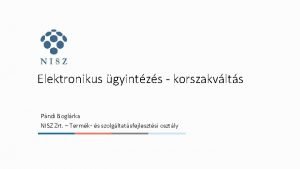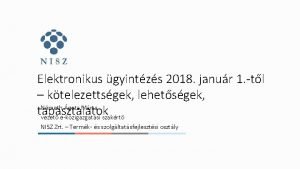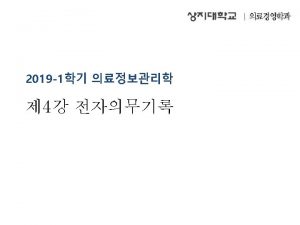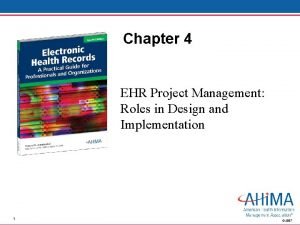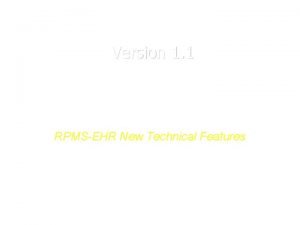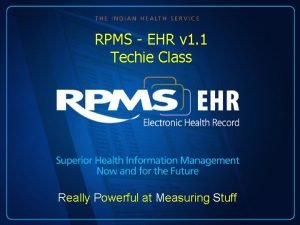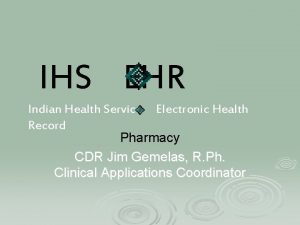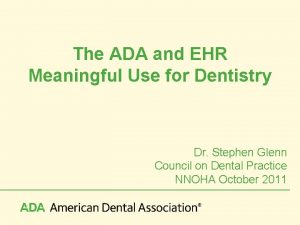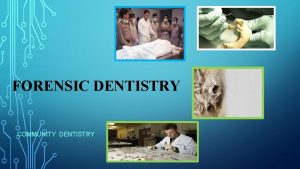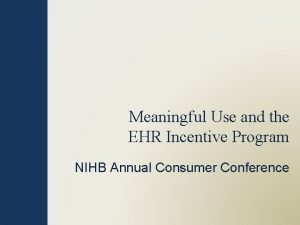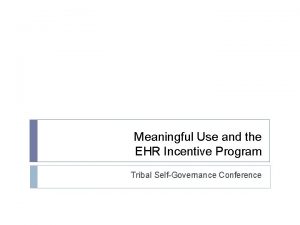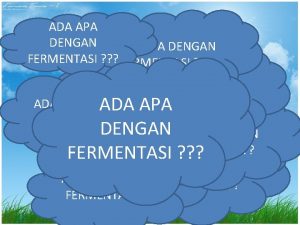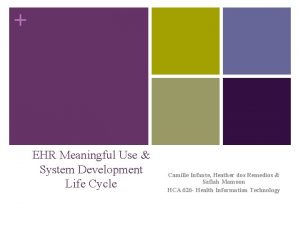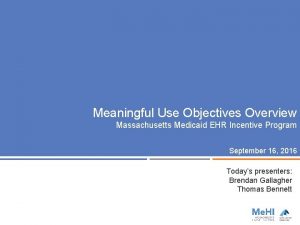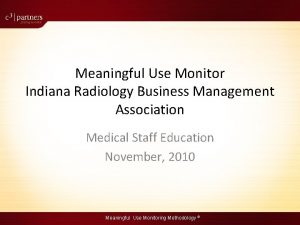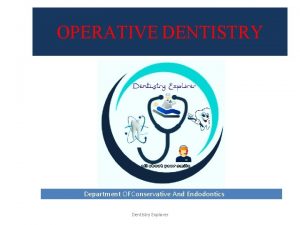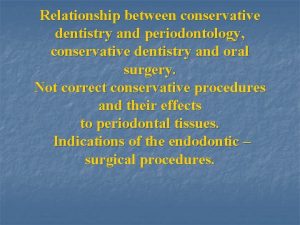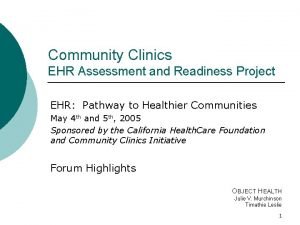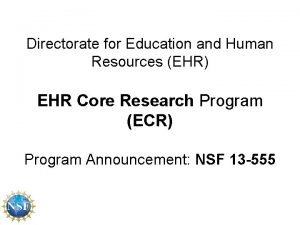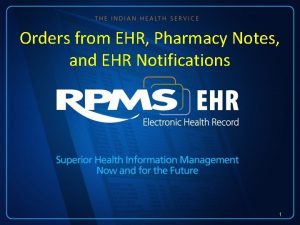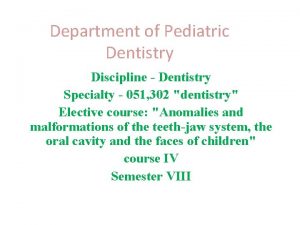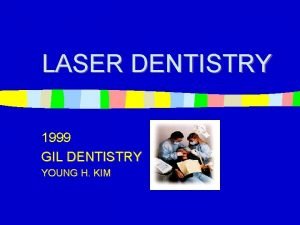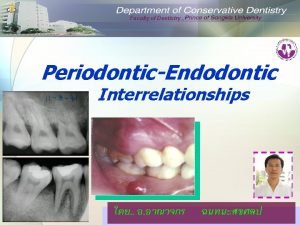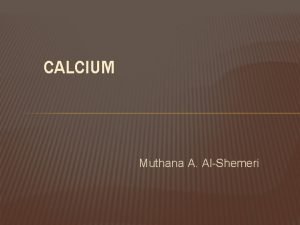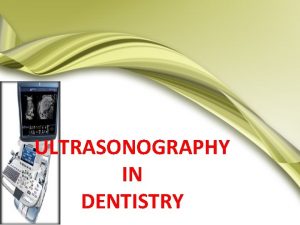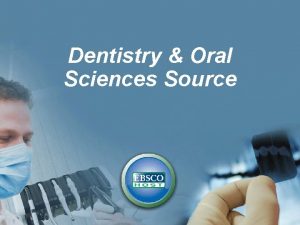The ADA and EHR Meaningful Use for Dentistry
















































- Slides: 48

The ADA and EHR Meaningful Use for Dentistry Dr. Stephen Glenn Council on Dental Practice NNOHA October 2011

About the ADA Vision To be the recognized leader on oral health. Mission The ADA is the professional association of dentists that fosters the success of a diverse membership and advances the oral health of the public. © 2011 American Dental Association, All Rights Reserved

Goals • Goal: Provide support to dentists so they may succeed and excel throughout their careers • Goal: Be the trusted resource for oral health information that will help people be good stewards of their own oral health • Goal: Improve public health outcomes through a strong collaborative profession, and through effective collaboration across the spectrum of our external stakeholders © 2011 American Dental Association, All Rights Reserved 3

About the ADA • Nearly 157, 000 U. S. dentists are members of the ADA • 68. 2% of all active, licensed dentists • 65. 4% of general practitioners • 79. 3% of specialists • 84. 3%of U. S. dental students © 2011 American Dental Association, All Rights Reserved

Introduction Certification EHR Meaningful Use 2013? 2014? 2015? © 2011 American Dental Association, All Rights Reserved

Objectives • Provide background information on Federal Electronic Health Record (EHR) initiatives • Discuss the Federal EHR Medicaid EHR incentive payment program • Present information on ADA activities to support dentists eligible for Medicaid Meaningful Use incentives • Provide other sources for information on EHR activities DISCLAIMER: The information given is not intended to provide either legal or professional advice. Dentists should consult directly with a qualified attorney or professional for appropriate legal or professional advice. Dentists should also consult with their chosen software vendor for advice on EHR hardware and software technology. © 2011 American Dental Association, All Rights Reserved

Background Most dentists are using practice management software today. Use of Practice Management Software 2006 © 2011 American Dental Association, All Rights Reserved

Paperless Practices 2006 % © 2011 American Dental Association, All Rights Reserved

www. ada. org/paperless

Scope of Incentive Program • The Medicaid EHR Incentive Program is voluntarily offered by individual states and territories and may begin as early as 2011, depending on the state. If a state decides to opt out of the incentive program, eligible professionals in that state will be unable to receive an incentive payment through Medicaid. • Eligible professionals can receive up to $63, 750 over the six years that they choose to participate in the program. • Eligible hospital incentive payments may begin as early as 2011, depending on when the state begins its program. The last year a Medicaid eligible professional or hospital may begin the program is 2016. © 2011 American Dental Association, All Rights Reserved

Medicaid Incentive Payments for EHRs Up to 17, 500 Dentists May Qualify for Medicaid EHR Incentives. Are you one of them? © 2011 American Dental Association, All Rights Reserved

Deadlines for EHR Adoption • Dentists who participate in the Medicaid EHR incentive program may or may not face deadlines as determined by their states. • There is no Federal deadline for adoption of Electronic Health Records (EHRs) by dentists who do not submit claims to Medicare. © 2011 American Dental Association, All Rights Reserved

Path to Medicaid Incentive Payments • Provider Eligibility • Certified EHR system (adopt, implement or upgrade) – www. onc. gov • Registration with CMS and your State • Demonstration of Meaningful use – www. cms. gov • ADA Overall Summary and Links for Dentists – www. ada. org/paperless © 2011 American Dental Association, All Rights Reserved

Eligibility for Medicaid EHR Incentives • Must be one of five types of eligible professionals (e. g. , dentists) • Must be licensed • Must not be on Office of the Inspector General (OIG) exclusion list • Must minimally either have – 30% Medicaid patient volume or – Practice predominantly in an FQHC or RHC with 30% or more needy individual patient volume © 2011 American Dental Association, All Rights Reserved

Eligibility for Medicare Incentives • Must be a ‘physician’ as defined by Medicare (e. g. , DDS/DMD) • Must have Part B Medicare allowed charges • Must not be hospital based • Must be enrolled in PECOS • Medicare eligibility is very limited for dentists. © 2011 American Dental Association, All Rights Reserved

ONC EHR Certification • ONC oversees the process. • Six ONC authorized testing and certification bodies are now approved/ • The Certified HIT Product List is maintained by ONC at the following site: http: //oncchpl. force. com/ehrcert/EHRProduct. Search? s etting=Ambulatory © 2011 American Dental Association, All Rights Reserved

Meaningful Use • Use of a certified EHR in a meaningful manner, such as e-prescribing • Use of certified EHR technology for electronic exchange of health information to improve quality of health care • Use of certified EHR technology to submit clinical quality measures and other measures © 2011 American Dental Association, All Rights Reserved

Reference Grids for Meaningful Use or Standards and Certification Criteria Final Rules • The Office of the National Coordinator for Health Information Technology • http: //healthit. hhs. gov/portal/server. pt? open= 512&mode=2&obj. ID=3584 © 2011 American Dental Association, All Rights Reserved

ADA EHR Activities ADA EHR Areas of Focus • Advocacy – ADA Council on Government Affairs • Certification – ADA Standards Committee on Dental Informatics (SCDI) • Liaison – ADA SCDI • Member – ADA Council on Dental Practice • Standards – ADA SCDI • Vocabulary – ADA Council on Dental Benefit Programs © 2011 American Dental Association, All Rights Reserved

ADA Working Groups • EHR: • Vocabulary – SNODENT • Member – Education/Communications • Advocacy • Standards/Liaison • Certification • Dental Quality Alliance © 2011 American Dental Association, All Rights Reserved

ADA EHR-Related Standards Activities • ADA Standards Committee on Dental Informatics – ADA SCDI • ADA Standards Committee on Dental Products – ADA SCDP • SNODENT (Systemized Nomenclature for Dentistry), a subset of SNOMED (Systemized Nomenclature for Medicine) © 2011 American Dental Association, All Rights Reserved

ADA Standards Activities • X 12/5010 Updates • WEDI • SCDP • ISO TC 215 • ISO TC 106 • IHE • IHTSDO © 2011 American Dental Association, All Rights Reserved

Why Standardize Electronic Health Information • The EHR along with seamless exchange of health information is the fundamental reason for interchange and interoperability • The absence of standards for electronic health information was a major obstacle in the past © 2011 American Dental Association, All Rights Reserved

Seamless Electronic Patient Records (1996: 694) • ADA maintains a vision: – Patient health data is confidential – Patient authorization of data available at time and place of care – EHR architecture should be open and compatible – patient health data unencumbered by boundaries – contributes toward improved quality of health outcomes and patient safety • EHR should be a collection of data in automated form, rather than an automated version of paper record © 2011 American Dental Association, All Rights Reserved

ANSI/ADA Specification 1039 • Standard patient-focused conceptual model developed and adopted in 2006. • Designed around the patient, the treatment plan, and the services provided to the patient. • Describes how the clinician needs information to make decisions to achieve best health care outcomes. © 2011 American Dental Association, All Rights Reserved

ANSI/ADA Specification 1039 Diagnostic-Therapeutic Cycle is a clinical process consisting of: • Data Acquisition • Diagnosis • Treatment Planning • Treatment © 2011 American Dental Association, All Rights Reserved

What makes up a clinical record? • Generally made up of a series of statements, which are sometimes: – Structured Data; – Fields in a form with answers; – Free-form sentences © 2011 American Dental Association, All Rights Reserved

Clinical Terminology and Classifications • Standardized method to structure EHR data in the software database tables • Important for ensuring that information exchanged has persistent meaning and context – “semantic interoperability” • Codes may be selected “behind the scenes” automatically using text descriptors or chosen directly by the provider © 2011 American Dental Association, All Rights Reserved

Vocabulary Needs • EHRs require uniform HIT standards, including common medical language • Data must be collected in a standardized format, with uniform definitions • Standard clinical terminologies and classifications represent a common medical language. © 2011 American Dental Association, All Rights Reserved

Difference Between Codes and Statements • Code for Dental Caries: – SNODENT Id: 118065 D • Statements: – The patient has dental caries – The patient had early childhood caries To make a record computer-understandable requires more than a list of codes © 2011 American Dental Association, All Rights Reserved

ICD Codes – Diagnostic Codes • International Classification of Diseases - Use can be traced back over 100 years. Originally designed to report mortality statistics. • Now used for administrative functions, epidemiologic studies, research, protocols, decision support © 2011 American Dental Association, All Rights Reserved

Reference Terminologies – Input Codes SNOMED CT ® – input method to codify clinical information captured in and EHR during patient care. – Immense size – Granular – Complex hierarchies • SNOMED CT ® Subsets - a set of SNOMED CT ® Concepts, Descriptions, or Relationships that is appropriate for deployment by a particular specialty organization. They are designed to help implementers by acting as a database view. SNOMED CT® was originally created by The College of American Pathologists. “SNOMED” and “SNOMED CT” are registered trademarks of the IHTSDO. © 2011 American Dental Association, All Rights Reserved

Systematized Nomenclature of Dentistry (SNODENT) • Subset of SNOMED CT ® including: – – Relevant anatomic sites Morphologic concepts Normal/abnormal functions Conditions and diseases of interest to dentistry • Purpose: • • Provide standardized terms for describing dental disease Capture clinical detail Capture patient characteristics Permit analysis of patient care services and outcomes © 2011 American Dental Association, All Rights Reserved

SNODENT History • SNODENT Timeline © 2011 American Dental Association, All Rights Reserved

SNODENT Update • Original SNODENT included 2600 concepts – updated version nearly 6000 • Eliminated concepts that were “Not otherwise specified” (NOS) • Identified “frequently used terms” • Added terms from the ADA health history form • Developed a new numbering system • Assigned concepts to hierarchies • Reviewed descriptions that were assigned to the concepts • Reviewed synonyms for the concepts • Developed a cross-walk from SNODENT-to-ICD-9 © 2011 American Dental Association, All Rights Reserved

Basic Elements of SNODENT • • Hierarchies Concepts Descriptions Attributes Various elements combine to create the “computer readable concept definition” © 2011 American Dental Association, All Rights Reserved

SNODENT Structure • Body Structure – • Head Structure (includes morphology – neoplasms and cysts, etc. ) • Clinical Findings – • Findings of the Mouth Region (e. g. , diagnosis, diseases, disorders, etc. ) • Observable entity – • Oral Cavity Function, Dental/Salivary Observations (e. g. , appearance of tongue, appearance of gingiva, tooth color, etc. ) • Physical Objects – • Devices (e. g. , intraoral devices, precision attachments, splints, orthodontic appliances, dentures, etc. ) • Substances – • Dental Materials (e. g. , fluoride gel, filling materials, root canal materials, waxes, pastes, implant materials, etc. ) © 2011 American Dental Association, All Rights Reserved

2011 - SNODENT Pilot Testers • Several Beta Tester License Agreements in process including: • Dental Schools • Government Agencies • Providers • Vendors • Health Systems © 2011 American Dental Association, All Rights Reserved

Secondary Uses of SNODENT • Administrative reporting – ICD-9/10 • Development of decision support systems • Development of evidence-based practice research © 2011 American Dental Association, All Rights Reserved

Dental Quality Alliance (DQA) • The mission of the Dental Quality Alliance is “to advance performance measurement as a means to improve oral health, patient care and safety through a consensus-building process”. • Annual Budget: $365, 000 © 2011 American Dental Association, All Rights Reserved

Background • In 2008, the Centers for Medicare and Medicaid Services (CMS) proposed that the American Dental Association (ADA) take the lead in establishing a Dental Quality Alliance (DQA) to develop performance measures for oral health care. • The ADA serves as the Secretariat for the DQA and provides both financial and In Kind support for its activities. © 2011 American Dental Association, All Rights Reserved

DQA Objectives • • • To identify and develop evidence-based oral health care performance measures and measurement resources. To advance the effectiveness and scientific basis of clinical performance measurement and improvement. To foster and support professional accountability, transparency, and value in oral health care through the development, implementation and evaluation of performance measurement. © 2011 American Dental Association, All Rights Reserved

Composition The Dental Quality Alliance is currently composed of 27 member organizations and ADA agencies. It has an Executive Committee and 4 advisory committees: • Implementation, Maintenance and Outcomes Assessment • Education and Communication • Governance and Finance • Research and Development of Performance Measures © 2011 American Dental Association, All Rights Reserved

Members • • • • • • • The current member organizations of the DQA are: Academy of General Dentistry Agency for Healthcare Research and Quality American Academy of Oral & Maxillofacial Pathology American Academy of Oral & Maxillofacial Radiology American Academy of Pediatric Dentistry American Academy of Periodontology American Association of Endodontists American Association of Oral and Maxillofacial Surgeons American Association of Orthodontists American Association of Public Health Dentistry American College of Prosthodontists American Dental Association’s Board of Trustees American Dental Education Assn American Dental Hygienists’ Assn American Medical Association America’s Health Insurance Plans Centers for Medicare and Medicaid Services Council on Access, Prevention, and Interprofessional Relationships (ADA) Council on Dental Benefit Programs (ADA) Council on Dental Practice (ADA) Council on Government Affairs (ADA) Delta Dental Health Resources and Services Administration Medicaid and SCHIP Dental Association National Association of Dental Plans Public Member The Joint Commission © 2011 American Dental Association, All Rights Reserved

ADA Member Publications Print • JADA • ADA News Electronic • JADA Online • ADA e-Publications • Practice & Thrive • Advocacy Update © 2011 American Dental Association, All Rights Reserved

ADA Website www. ada. org/paperless © 2011 American Dental Association, All Rights Reserved

Additional ADA Resources • ADA www. ada. org/paperless provides links to – Electronic Health Records – Dental Records – Frequently Asked Questions (FAQs) – Glossary of Dental Clinical and Administrative Terms – National Health Information Infrastructure (NHIN) – Provisions of HITECH of Interest to Dentists • Journal of the American Dental Association (JADA) © 2011 American Dental Association, All Rights Reserved

Additional Resources • Department of Health and Human Resources (DHHS) – Center for Medicare and Medicaid Services (CMS) – ONCHIT • National Institute of Standards and Technology (NIST) – Guidance on EHR Usability – Health Information Standards and Testing • Agency for Health Research and Quality (AHRQ) • National Network for Oral Health Access (NNOHA) © 2011 American Dental Association, All Rights Reserved
 Snodent
Snodent Meaningful use chart
Meaningful use chart Loinc meaningful use
Loinc meaningful use Gaya ada yang ... dan ada pula yang
Gaya ada yang ... dan ada pula yang Dalam laporan percobaan tidak ada urutan waktu tetapi ada
Dalam laporan percobaan tidak ada urutan waktu tetapi ada Negasi dari jika ada gula maka ada semut adalah
Negasi dari jika ada gula maka ada semut adalah Communicative language teaching شرح
Communicative language teaching شرح Lays a moral and meaningful foundation for life
Lays a moral and meaningful foundation for life What is data converted into a meaningful and useful context
What is data converted into a meaningful and useful context Nextgen ehr tips and tricks
Nextgen ehr tips and tricks Ehr alerts and reminders
Ehr alerts and reminders Nextgen crystal reports
Nextgen crystal reports Simbang gabi prayer
Simbang gabi prayer Graphics icons and images
Graphics icons and images A meaningful, authentic good life is based on
A meaningful, authentic good life is based on Meaningful work statement
Meaningful work statement Meaningful diction
Meaningful diction Making math meaningful
Making math meaningful Meaningful engagement definition
Meaningful engagement definition Meaningful reception
Meaningful reception Meaningful drill
Meaningful drill Random marks
Random marks Examples of derivative subsumption
Examples of derivative subsumption Failyail
Failyail David ausubel theory
David ausubel theory Meaningful life positive psychology
Meaningful life positive psychology Advance organizer betekenis
Advance organizer betekenis Form meaningful sentences
Form meaningful sentences To create a meaningful performance report
To create a meaningful performance report Twitter
Twitter Equidistantw
Equidistantw Meaningful gesture
Meaningful gesture Preceptorship definition
Preceptorship definition Meaningful leadership experience
Meaningful leadership experience Meaningful learning experiences examples
Meaningful learning experiences examples Planned parenthood ehr
Planned parenthood ehr Pssproject
Pssproject Paltc ehr
Paltc ehr Tribal health ehr
Tribal health ehr Szuf lekérdezés
Szuf lekérdezés Avdh-dhsz
Avdh-dhsz San francisco hospital
San francisco hospital Gantt chart for ehr implementation
Gantt chart for ehr implementation Ehr nijmegen
Ehr nijmegen Iuse ehr
Iuse ehr Ehr implementation work breakdown structure
Ehr implementation work breakdown structure Rpms ehr
Rpms ehr Rpms ehr
Rpms ehr Tribal health emr
Tribal health emr
